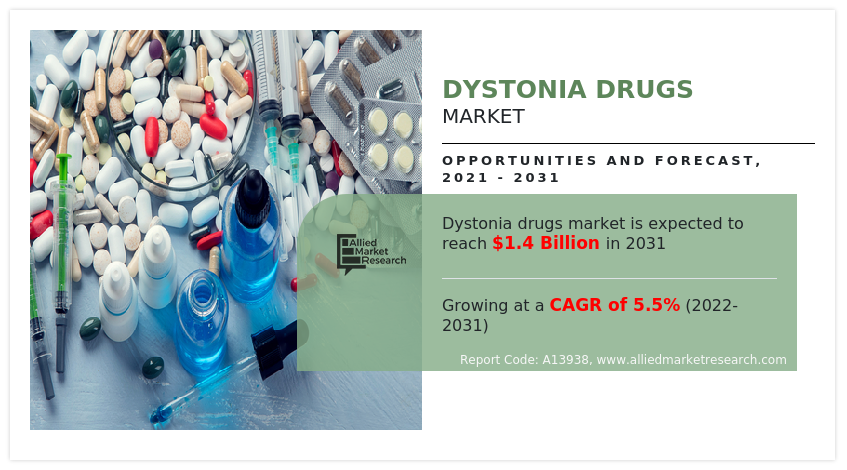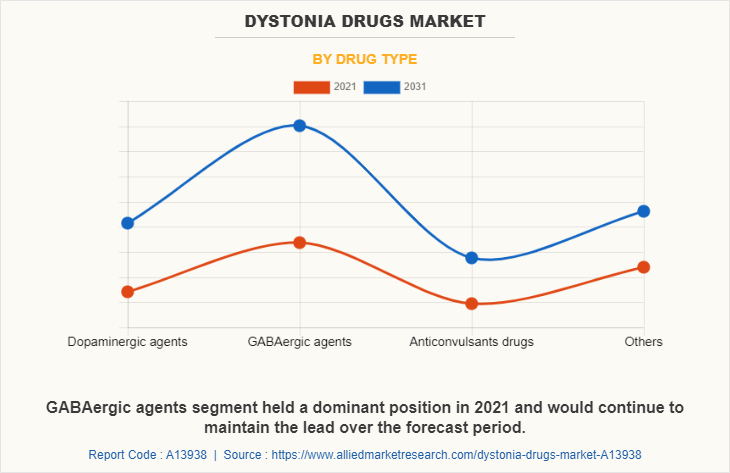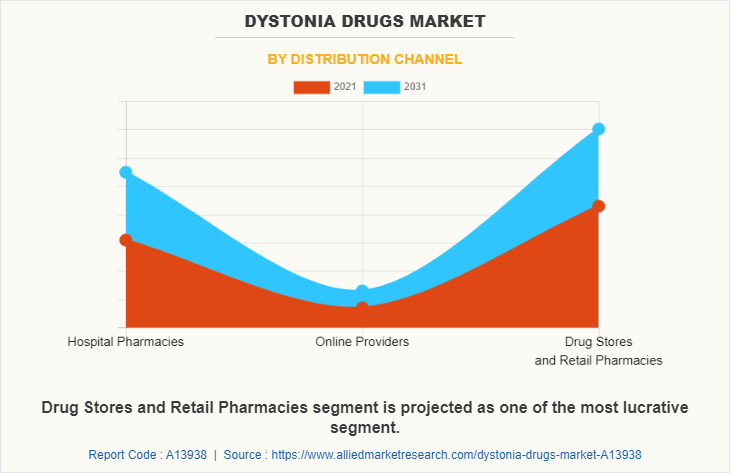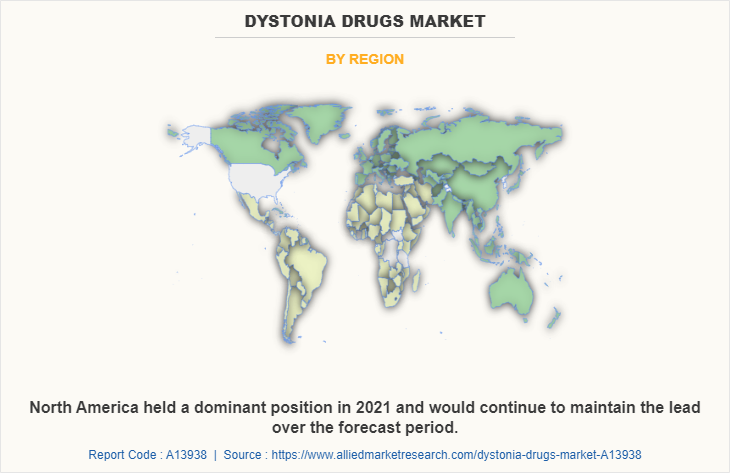Dystonia Drugs Market Research, 2031
The global dystonia drugs market size was valued at $806.7 million in 2021, and is projected to reach $1,378.67 million by 2031, growing at a CAGR of 5.5% from 2022 to 2031. Dystonia may be defined as a movement disorder characterized by involuntary muscle contractions which causes slow repetitive movements or abnormal postures. This muscle contractions lead to abnormal muscle movements and body postures. There are several forms of dystonia affecting a single muscle, or a group of muscles or may affect muscles throughout the body. It is caused due to conditions such as brain injury during or around the time of birth, certain infections, brain trauma, or various vascular abnormalities such as stroke, arteriovenous and others. It causes painful movements or may lead to tremors in the patients. There is no specific treatment for dystonia but its symptoms can be relieved through the use of certain medications.

“The dystonia drugs market was negatively impacted during the lockdown period, due to decreased patient visits to the hospitals for diagnosis and treatment of diseases other than COVID-19, and due to the public health regulations and social distancing. The government funding, medical schemes and focus of healthcare services were reduced and shifted towards the COVID-19, which negatively impacted the dystonia drugs market size.”
Market Dynamics
The growth of the dystonia drugs market is expected to be driven by high potential in untapped, emerging markets, due to availability of improving healthcare infrastructure, increase in unmet healthcare needs, and surge in demand for advanced healthcare facilities. In addition, increase in incidences of dystonia and also increase in prevalence of other neurological disorders having dystonia symptoms is driving the growth of the market. According to an article published in 2020, by National Organization for Rare Disorders, Inc. (NORD), there were an estimated 300,000 people in North America, affected by the various forms of dystonia. This rise in incidence of dystonia, increases the demand for dystonia treatment medications which further propels the growth of the dystonia drugs market share.
In addition, increase in research and development activities in developed as well as developing regions, is propelling the growth of the dystonia drugs market. There has been a tremendous increase in research activities by the researchers to develop and innovate new therapies for the treatment of various health conditions. Researchers are mainly focusing on developing novel drug molecules that are highly effective and potent in nature. Innovations are also seen in the field of drug development for manufacturing of effective dystonia drug therapies. Thus, increase in such researches is driving the growth of dystonia drug market.
Furthermore, the healthcare industry in emerging economies is developing at a significant rate, owing to rise in demand for enhanced healthcare services, significant investments by government to improve healthcare infrastructure, and development of the medical tourism industry in emerging countries. This is anticipated to drive the market during the dystonia drugs market forecast period.
Though several factors boost the growth of dystonia drugs market, factors such as lack of awareness among the population in underdeveloped countries about the dystonia provides hindrance to the dystonia drugs market growth. In addition, low purchasing power of people in underdeveloped and developing economies also acts as a restraint to the growth of the market in regions such as Asia-Pacific and LAMEA. However, technological advancements in pharmaceutical manufacturing and new product innovations and its launch and approval in the market is anticipated to drive the market during the forecast period.
Furthermore, the outbreak of COVID-19 has disrupted workflows in the health care sector around the world. The disease has forced a number of industries to shut their doors temporarily, including several sub-domains of health care. The global dystonia drugs market experienced a decline in 2020 due to global economic recession led by COVID-19. In addition, the COVID-19 outbreak disrupted the supply chain across various end-user industries like food & beverage, healthcare, and industrial.
In addition, number of diagnosis and treatment procedures were decreased due to factors such as public health regulations and social distancing. There was also a decrease in access to primary health care and specialist care along with lack of transportation services for public which caused hindrance to the growth of the market during the pandemic. In addition, patients also refused to seek care and treatment for diseases other than COVID-19 due to increased risk of corona virus infection. However, the market is anticipated to witness recovery after regularization of the supply chain post pandemic, and show stable growth in the coming future.
Segmental Overview
The global dystonia drugs market is segmented on the basis of drug type, distribution channel and region. By drug type, the market is categorized into dopaminergic agents, GABAergic agents, anticonvulsants drugs, and others. On the basis of route of administration, the market is segmented into oral and injectable. Based on distribution channel, the market is categorized into hospital pharmacies, online providers and drug stores and retail pharmacies. Region wise, the market is analyzed across North America (the U.S., Canada, and Mexico), Europe (Germany, France, the UK, Italy, Spain, and rest of Europe), Asia-Pacific (Japan, China, Australia, India, South Korea, and rest of Asia-Pacific), and LAMEA (Brazil, South Africa, Saudi Arabia, and rest of LAMEA).

By drug type the GABAergic agents segment dominated the global market in 2021, and is expected to remain dominant throughout the forecast period, owing the increase in prescription of GABAergic agents by healthcare practitioner owing to advantages offered by it in treatment dystonia specifically cervical dystonia. Moreover, development of highly efficient and potent GABAergic agent's medications for treatment of dystonia is also driving the growth of dystonia drugs market.
By Route Of Administration
Oral segment is projected as one of the most lucrative segment.
By route of administration the oral segment dominated the market in 2021, owing to the high permeability, drug solubility, and environmental stability in the gastrointestinal tract, along with cost effectiveness of the medications. On the other hand, injection segment is expected to grow at a fastest CAGR owing to increase in developments in parenteral dosing, along with increased R&D in botulinum injections.

By distribution channel the drug stores and retail pharmacies segment held the largest market share in 2021, as it is the oldest and most conventional medium of distributing medications to consumers, owing to its large chain of distribution networks. On the other hand, online providers segment is expected to remain dominant throughout the forecast period, owing to easy accessibility, time saving and heavy discounts & offers provided by these online platforms.

By region the dystonia drugs industry is analyzed across North America, Europe, Asia-Pacific, and LAMEA. North America accounted for a major share of the dystonia drugs market in 2021, and is expected to maintain its dominance during the forecast period. In regional analysis, the U.S. dominated the market in 2021, and is expected to grow at the fastest rate during the forecast period.
Presence of several major players, such as Abbott Laboratories, Sorrento Therapeutics, Inc, Amneal Pharmaceuticals LLC and others is driving the market growth in North America. Moreover, there is a huge advancement in manufacturing technology of dystonia medications by the companies in this region which is anticipated to drive the growth of the market during the forecast period.
In addition, rise in incidences of dystonia along with increase in prevalence of other neurological conditions causing dystonia in U.S. population and other major countries is the key factor for increasing the demand for dystonia drugs in North America. Furthermore, presence of well-established healthcare infrastructure, high purchasing power, and rise in diagnosis and treatment of dystonia in North America are expected to drive the market growth in this region. Moreover, presence of a large unmet healthcare needs and a favorable regulatory environment are some of the key factors that are expected to increase profitable growth of the market over the forecast period.
Moreover, North America constitutes a major market for the dystonia drugs market owing to the increased awareness among the people about the dystonia disease and the availability of high quality and efficient medications for its treatment in this region.
On the other hand, Asia-Pacific expected to grow at the highest rate during the forecast period. On the basis of regional analysis, Japan dominated the market in Asia-pacific region, and China is anticipated to grow at the fastest rate during the forecast period. Asia-Pacific offers profitable opportunities for key players operating in the dystonia drugs market, thereby registering the fastest growth rate during the forecast period, owing to the growing infrastructure of industries, rising disposable incomes, as well as well-established presence of domestic companies in the region.
The market growth in this region is attributable to presence of pharmaceutical companies in the region as well as growing purchasing power of populated countries, such as China and India. Moreover, increase in awareness regarding dystonia and its treatment procedures in the population is anticipated to drive the market during the forecast period.
Furthermore, the Asia-Pacific region exhibits the largest pharmaceutical supply with availability of raw material in abundance, which can be easily accessed by manufacturers of dystonia drugs. This, in turn, is anticipated to drive the growth of the market.
Competitive Analysis
Competitive analysis and profiles of the major players in the dystonia drugs market, such as AbbVie Inc., Amneal Pharmaceuticals LLC, F. Hoffmann-La Roche Ltd, Hameln pharma Gmbh, Ipsen Pharma, Merz Pharmaceuticals, LLC, Novartis AG, Pfizer Inc., Teva Pharmaceutical Industries Limited and Wellona Pharma are provided in this report. There are some important players in the market such as Janssen Global Services, LLC, and others. Major players have adopted product launch, collaboration, acquisition, agreement, clinical trials and others as key developmental strategies to improve the product portfolio of the dystonia drugs market.
Some Examples of Product Launch in The Market
In June 2022, Amneal Pharmaceuticals, Inc. announced the commercial launch of LYVISPAH, a baclofen oral granules specialty product approved by the U.S. Food and Drug Administration for the treatment of spasticity related to multiple sclerosis and other spinal cord disorders.
Acquisitions in The Market
In May 2020, AbbVie announced the acquisition of Allergan plc. a biopharmaceutical company offering products in immunology, hematologic, oncology, neuroscience, and allergan aesthetics.
Collaboration in The Market
In March 2022, AbbVie announced a new co-development and license agreement with Gedeon Richter Plc. to research, develop and commercialize novel dopamine receptor modulators for the potential treatment of neuropsychiatric diseases.
Agreements in The Market
In January 2023, Amneal Pharmaceuticals, Inc. announced a long-term license agreement with Orion Corporation to commercialize a number of Amneal’s complex generic products in to market in Europe, Australia, and New Zealand.
In January 2022, Amneal Pharmaceuticals, Inc. announced a definitive agreement with Saol Therapeutics, to acquire Saol’s Baclofen franchise, including Lioresal and LYVISPAHTM as well as a pipeline product under development.
Key Benefits For Stakeholders
- This report provides a quantitative analysis of the market segments, current trends, estimations, and dynamics of the dystonia drugs market analysis from 2021 to 2031 to identify the prevailing dystonia drugs market opportunity.
- The market research is offered along with information related to key drivers, restraints, and opportunities.
- Porter's five forces analysis highlights the potency of buyers and suppliers to enable stakeholders make profit-oriented business decisions and strengthen their supplier-buyer network.
- In-depth analysis of the dystonia drugs market segmentation assists to determine the prevailing market opportunities.
- Major countries in each region are mapped according to their revenue contribution to the global market.
- Market player positioning facilitates benchmarking and provides a clear understanding of the present position of the market players.
- The report includes the analysis of the regional as well as global dystonia drugs market trends, key players, market segments, application areas, and market growth strategies.
Dystonia Drugs Market Report Highlights
| Aspects | Details |
| Market Size By 2031 | USD 1.4 billion |
| Growth Rate | CAGR of 5.5% |
| Forecast period | 2021 - 2031 |
| Report Pages | 210 |
| By Drug Type |
|
| By Route of Administration |
|
| By Distribution Channel |
|
| By Region |
|
| Key Market Players | Hameln Pharma Gmbh, F. Hoffmann-La Roche Ltd., Wellona Pharma, Abbvie Inc, Pfizer Inc., Amneal Pharmaceuticals LLC, Teva Pharmaceutical Industries Limited, Novartis AG, Ipsen Pharma, Merz Pharmaceuticals, LLC |
Analyst Review
This section provides various opinions of top-level CXOs in the global dystonia drugs market. According to the insights of CXOs, the increase in demand for dystonia drugs as a result of increase in incidences of dystonia is expected to offer profitable opportunities for the expansion of the market. Also, rise in prevalence of other neurological conditions and increase in R&D activities in the pharmaceutical field is boosting the growth of dystonia drugs market.
CXOs further added that increase in the demand of novel therapies for treatment of dystonia owing to large cases of dystonia condition has largely contributed to the market revenue in 2021 and is expected to maintain this trend throughout the forecast period. Also, the increase in awareness around the globe regarding dystonia and its treatment options increases its demand in the healthcare sector and thus significantly contributes towards revenue generation. Moreover, improving healthcare infrastructure, increasing investment and surge in healthcare expenditure is propelling the dystonia drug market.
Furthermore, North America is expected to witness highest growth, in terms of revenue, owing due to the well-established health coverage and high level of awareness regarding the illness along with government initiatives promoting awareness drives, lead to the growth of the market. However, Asia-Pacific is anticipated to witness notable growth, owing to increase in investments for manufacturing of medicines and other pharmaceutical products and upsurge in healthcare expenditure in the emerging economies such as India and China.
Increase in incidences of dystonia in developed and developing regions, along with increase in prevalence of conditions such as Parkinson's disease and Huntington's disease are the upcoming trends of Dystonia Drugs Market in the world.
Parkinson's disease is the leading application of Dystonia Drugs Market.
North America is the largest regional market for Dystonia Drugs.
Dystonia Drugs Market is projected to reach $1,378.67 million by 2031, registering a CAGR of 5.5% from 2022 to 2031.
Major Key players that operate in the global Dystonia Drugs Market are AbbVie Inc., Amneal Pharmaceuticals LLC., F. Hoffmann-La Roche Ltd, Hameln Pharma GmbH, Ipsen Pharma, Merz Pharmaceuticals, LLC, Novartis AG, Pfizer Inc., Teva Pharmaceuticals and Wellona Pharma.
Yes, the Dystonia Drugs market report provides PORTER Analysis.
The base year is 2021 in Dystonia Drugs market.
Loading Table Of Content...



